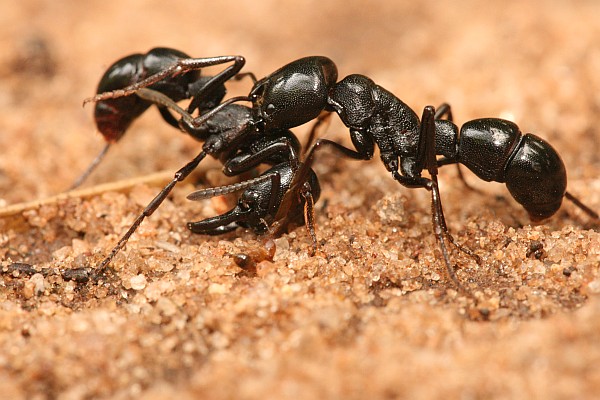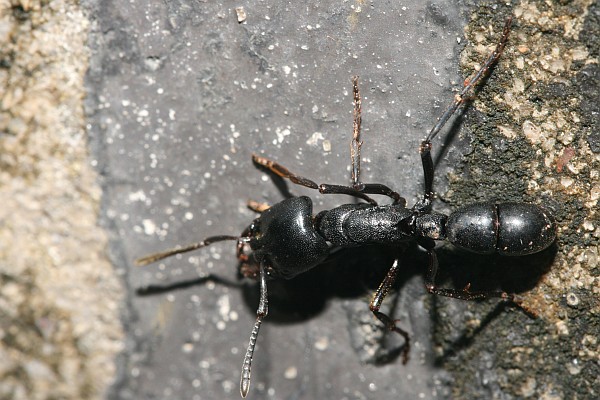Diptera.info :: Identification queries :: Other insects, spiders, etc.
Who is here? 1 guest(s)
|
Large black ants
|
|
| Muhammad Mahdi |
Posted on 30-01-2010 01:50
|
|
Member Location: Dar es Salaam, Tanzania Posts: 447 Joined: 26.12.08 |
Hi, I found these enormous large black ants in Dar es Salaam, Tanzania after some heavy rainfalls. In the past I had only seen the ant once or twice but after the rainfall I saw around 6-7 in a day. The ants were solitary. They were all alone except for one fighting pair. App 2-3cm long Muhammad Mahdi attached the following image:  [76Kb] Muhammad ____________________ www.micro2macro.net |
| Muhammad Mahdi |
Posted on 30-01-2010 01:51
|
|
Member Location: Dar es Salaam, Tanzania Posts: 447 Joined: 26.12.08 |
A lone one
Muhammad Mahdi attached the following image:  [83.65Kb] Muhammad ____________________ www.micro2macro.net |
| Muhammad Mahdi |
Posted on 31-01-2010 15:28
|
|
Member Location: Dar es Salaam, Tanzania Posts: 447 Joined: 26.12.08 |
Any idea?
Muhammad ____________________ www.micro2macro.net |
| Kirsten Eta |
Posted on 03-02-2010 23:37
|
|
Member Location: Northern Germany Posts: 87 Joined: 06.10.06 |
Hello Muhammad, they should be from the family Lasius and look near Lasius fuliginosus, but sorry, can't give you more information. Friendly regards Kirsten |
|
|
|
| cthirion |
Posted on 03-02-2010 23:48
|
|
Member Location: Awirs (Flémalle) Belgique Posts: 901 Joined: 13.08.04 |
2-3 cm long??????Lasius fuliginosus- Tchernobyl?
cthirion |
| Paul Beuk |
Posted on 03-02-2010 23:48
|
|
Super Administrator Location: Netherlands Posts: 19365 Joined: 11.05.04 |
Kirsten, these are from Africa (in case you missed that) and they certainly are not Lasius. They are not Formicinae at all.
Paul - - - - Paul Beuk on https://diptera.info |
| Muhammad Mahdi |
Posted on 04-02-2010 14:03
|
|
Member Location: Dar es Salaam, Tanzania Posts: 447 Joined: 26.12.08 |
Paul, they are not ants? Then what are they, I m curious Muhammad ____________________ www.micro2macro.net |
| Paul Beuk |
Posted on 04-02-2010 14:55
|
|
Super Administrator Location: Netherlands Posts: 19365 Joined: 11.05.04 |
You misreadthe name, they are not Formicinae. They are Ponerinae.
Paul - - - - Paul Beuk on https://diptera.info |
| Muhammad Mahdi |
Posted on 06-02-2010 15:46
|
|
Member Location: Dar es Salaam, Tanzania Posts: 447 Joined: 26.12.08 |
Oh, crazy me Any idea which genus? Could you suggest a specialist? These ants were very striking and I am interested in knowing about them. Muhammad ____________________ www.micro2macro.net |
| Muhammad Mahdi |
Posted on 08-02-2010 16:28
|
|
Member Location: Dar es Salaam, Tanzania Posts: 447 Joined: 26.12.08 |
paul?
Muhammad ____________________ www.micro2macro.net |
| Xespok |
Posted on 08-02-2010 16:41
|
|
Member Location: Debrecen, Hungary Posts: 5550 Joined: 02.03.05 |
Post it at www.ameisenforum.de. You will get an answer there.
Gabor Keresztes Japan Wildlife Gallery Carpathian Basin Wildlife Gallery |
| Paul Beuk |
Posted on 08-02-2010 23:53
|
|
Super Administrator Location: Netherlands Posts: 19365 Joined: 11.05.04 |
I received this message from Barry: Dear Paul,
Yes, the photographs are certainly of a species of Plectroctena. I can not tell if it is P. mandibularis or P. strigosa from the photos, but it is one of those two. Best regards Barry Paul - - - - Paul Beuk on https://diptera.info |
| Muhammad Mahdi |
Posted on 09-02-2010 04:19
|
|
Member Location: Dar es Salaam, Tanzania Posts: 447 Joined: 26.12.08 |
Thanks Paul. You've been a great help. Xespok, thanks for that other site. Muhammad ____________________ www.micro2macro.net |
| Muhammad Mahdi |
Posted on 09-02-2010 04:21
|
|
Member Location: Dar es Salaam, Tanzania Posts: 447 Joined: 26.12.08 |
Oh, one more thing. The two ants fighting, is it common? Are the ants cannibalistic? Muhammad ____________________ www.micro2macro.net |
| Muhammad Mahdi |
Posted on 12-02-2010 16:36
|
|
Member Location: Dar es Salaam, Tanzania Posts: 447 Joined: 26.12.08 |
Paul?
Muhammad ____________________ www.micro2macro.net |
| Xespok |
Posted on 12-02-2010 17:02
|
|
Member Location: Debrecen, Hungary Posts: 5550 Joined: 02.03.05 |
Probably territorial rivalry. In most ant species colonies own a particular piece of habitat and they fight the members of neighboring colonies if they wander to foreign land. The recognition is based on smell. Sometimes wars between colonies erupt and one colony takes over the territory of a smaller weaker colony..
Gabor Keresztes Japan Wildlife Gallery Carpathian Basin Wildlife Gallery |
| Muhammad Mahdi |
Posted on 12-02-2010 18:09
|
|
Member Location: Dar es Salaam, Tanzania Posts: 447 Joined: 26.12.08 |
Wow. That's amazing. Thanks. Muhammad ____________________ www.micro2macro.net |
| Jump to Forum: |















